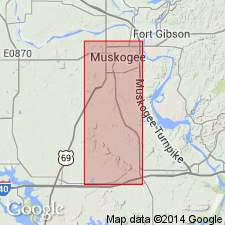
- Usage in publication:
-
- Pope Chapel sandstone member*
- Modifications:
-
- Named
- Dominant lithology:
-
- Sandstone
- AAPG geologic province:
-
- Chautauqua platform
Summary:
Named as a member (1 of 6 named members) of Atoka formation. Name Atoka is one of five formations assigned to some rocks formerly included in the Winslow formation. [Status of Winslow as a result of this study not clearly stated.] Named from exposure at Pope Chapel in sec 24, T12N, R19E, Muskogee Co, OK on the Chautauqua platform. No type locality designated. Area of this report is in Muskogee Co. Consists of highly colored--usually red, brown, yellow or white, coarse- to medium-grained, saccharoidal, massive to irregularly bedded sandstone containing clay blebs. Is 50 ft thick. Separated from underlying Coata sandstone member (new) of Atoka by 150-220 ft of fissile, gray shale with many calcareous layers. Separated from overlying Georges Fork sandstone member (new) of Atoka by 80-120 ft of shale which is usually concealed. The underlying and overlying shales are unnamed units of the Atoka. Stratigraphic table. Columnar section. Of Early Pennsylvanian age.
Source: GNU records (USGS DDS-6; Denver GNULEX).
For more information, please contact Nancy Stamm, Geologic Names Committee Secretary.
Asterisk (*) indicates published by U.S. Geological Survey authors.
"No current usage" (†) implies that a name has been abandoned or has fallen into disuse. Former usage and, if known, replacement name given in parentheses ( ).
Slash (/) indicates name conflicts with nomenclatural guidelines (CSN, 1933; ACSN, 1961, 1970; NACSN, 1983, 2005, 2021). May be explained within brackets ([ ]).

